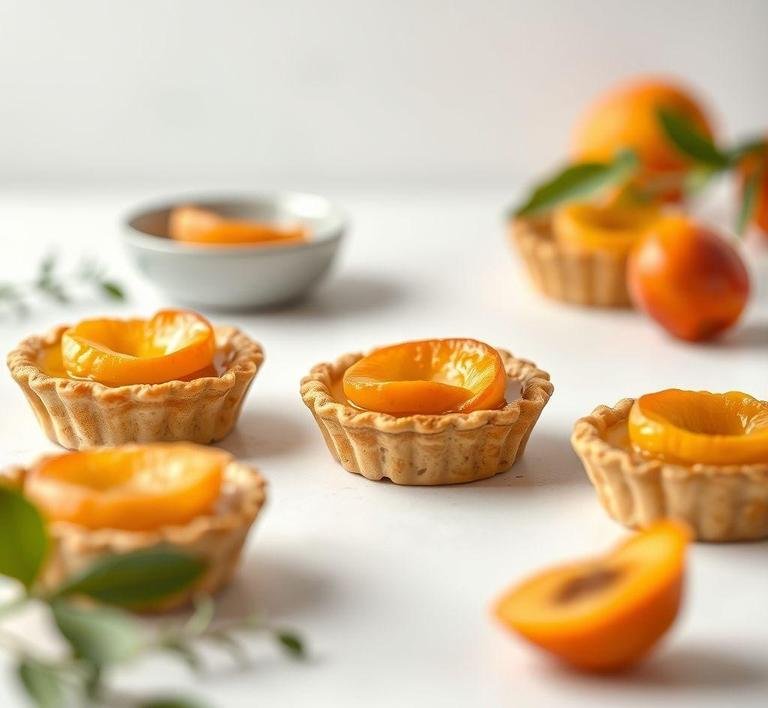Mary Berry’s Apricot Portuguese Tarts are a delightful twist on the classic Portuguese custard tart, or pastéis de nata, with a subtle sweetness of apricot jam incorporated into the recipe. These tarts are inspired by the rich and buttery pastéis de nata, which have a long history in Portuguese cuisine and are famous for their crispy, flaky pastry shells and creamy custard filling. Mary Berry, a celebrated British baker and television personality, puts her unique spin on this iconic pastry by infusing the custard with apricot jam, lending a slight fruity tang that contrasts beautifully with the sweetness of the custard and the richness of the pastry.
The apricot jam adds not just flavor but also a glossy sheen to the top of the tart, making them visually appealing as well. These tarts are a perfect treat for any occasion, whether it’s a family gathering, afternoon tea, or even a special event. They combine the best of both worlds – the elegance of a Portuguese classic and the comforting, familiar flavors of apricot, making them irresistible to anyone who loves pastries.
Mary Berry’s Apricot Portuguese Tarts Recipe
Ingredients Needed

To recreate Mary Berry’s Apricot Portuguese Tarts, you’ll need a selection of basic ingredients that come together to create the perfect balance of flavor and texture. Here’s a comprehensive list of what you’ll need:
- Ready-made Puff Pastry – The foundation of any good tart. Puff pastry is known for its light and flaky texture, which becomes beautifully crisp when baked. Using pre-made puff pastry saves time, but you can also opt for homemade puff pastry if you’re up for the challenge.
- Double Cream – This luxurious ingredient is what makes the custard filling rich and creamy. Double cream adds depth of flavor and a velvety texture that makes the tarts irresistible.
- Full-Fat Milk – A key ingredient to balance the richness of the double cream, full-fat milk ensures the custard isn’t too heavy while still contributing to the silky smooth texture.
- Egg Yolks – The egg yolks act as the thickening agent in the custard, helping it set into the perfect consistency. They also add a rich golden color to the filling.
- Granulated Sugar – For sweetness, granulated sugar is mixed into the custard. It helps to enhance the flavor profile without overpowering the other ingredients.
- Vanilla Extract – A few drops of vanilla extract add a warm, aromatic flavor that complements the other ingredients, enhancing the custard’s richness.
- Apricot Jam – The star ingredient in this version of the tart! Apricot jam is used to top the tarts once baked, adding a glossy finish and a touch of fruity sweetness. It’s also brushed on the surface of the pastry before baking to help create a lovely golden hue.
- Lemon Zest – A small amount of lemon zest adds a burst of freshness that cuts through the richness of the custard, balancing the flavors and giving the tarts a citrusy lift.
- Cornflour (Cornstarch) – Cornflour helps to thicken the custard and ensures it holds together once baked, so you don’t end up with a runny filling.
Equipment Needed
To make Mary Berry’s Apricot Portuguese Tarts, you’ll need a few essential pieces of kitchen equipment to ensure the recipe is executed flawlessly. Here’s what you’ll need:
- Muffin Tin or Tart Tin – These tarts are baked in individual portions, so a standard muffin tin or tart tin with at least 12 holes is necessary to form the perfect mini tarts.
- Rolling Pin – While you can use store-bought puff pastry, you’ll still need a rolling pin to roll it out thin enough to fit into the tart cases. This ensures the pastry crisps up and forms a delicate base for the custard filling.
- Saucepan – A small to medium saucepan is required to heat the milk, cream, and sugar for the custard base. A good saucepan with a heavy bottom is ideal for ensuring even heating.
- Whisk – A whisk is essential for mixing the egg yolks and sugar together. It also helps to combine the milk and cream mixture smoothly when making the custard.
- Sifter or Fine Mesh Strainer – A sifter will help you incorporate the cornflour smoothly into the mixture, avoiding any lumps in the custard. It’s also useful to strain the mixture if needed for a smooth texture.
- Pastry Brush – A pastry brush is used to lightly brush the apricot jam onto the pastry shells before baking and also to apply a glossy layer after baking.
- Cooling Rack – Once your tarts are baked to perfection, it’s important to allow them to cool properly, so a cooling rack is essential to prevent them from getting soggy.
Instructions To Make Mary Berry’s Apricot Portuguese Tarts
Now that you have your ingredients and equipment ready, it’s time to dive into the steps to create these delicious Apricot Portuguese Tarts. Follow these detailed instructions to make the tarts from start to finish:
- Preheat the Oven – Preheat your oven to 200°C (180°C fan) or 400°F. This ensures that the oven is at the right temperature to bake the tarts perfectly.
- Prepare the Pastry Shells – Roll out the puff pastry on a lightly floured surface. You want to roll it thin enough so it can fit into the individual tart cases, but not so thin that it becomes brittle. Cut out circles of pastry using a round cutter, slightly larger than the holes in your muffin tin. Gently place the pastry circles into the muffin tin, pressing down to fit the sides. Make sure the pastry is snug but not stretched. Chill the lined tart tin in the fridge while you prepare the custard.
- Make the Custard – In a saucepan, heat the milk, double cream, and sugar over medium heat until it begins to steam. Don’t let it come to a boil. In a separate bowl, whisk the egg yolks, cornflour, and vanilla extract together until smooth. Gradually pour a little bit of the hot milk mixture into the egg yolks, whisking constantly to temper the eggs (this prevents them from scrambling). Slowly pour the egg mixture back into the saucepan, whisking continuously. Cook the custard over low heat, stirring constantly, until it thickens. Once thickened, remove the saucepan from the heat and set aside.
- Assemble the Tarts – Spoon the custard mixture into the prepared pastry shells, filling them almost to the top. Smooth the tops gently with the back of the spoon.
- Brush with Apricot Jam – Heat the apricot jam gently in a small saucepan or microwave until it becomes runny. Brush a thin layer of the warm apricot jam over the top of each tart, ensuring it is evenly coated.
- Bake the Tarts – Place the muffin tin into the preheated oven and bake for 15-20 minutes, or until the pastry is golden brown and the custard is set. The tarts should have a beautiful golden color, with the apricot jam adding a glossy finish.
- Cool and Serve – Once baked, remove the tarts from the oven and let them cool in the tin for a few minutes before transferring them to a cooling rack. Allow them to cool completely before serving.
Tips And Tricks
- Chill the Pastry – Chilling the pastry before baking helps it hold its shape and prevents it from shrinking in the oven. It also helps the pastry puff up beautifully.
- Use a Tart Pan – If you don’t have a muffin tin, you can also use individual tart pans. These may help create a slightly more delicate and refined shape for the tarts.
- Perfect Custard Texture – When making the custard, be sure to whisk constantly and not rush the process. Cooking the custard slowly and steadily will ensure a smooth and velvety texture.
- Use Homemade Jam – If you have the time and inclination, homemade apricot jam can add an extra layer of richness and authenticity to the tarts.
- Serve Warm – While these tarts can be served at room temperature, they’re particularly delicious when served slightly warm, allowing the custard to remain creamy and indulgent.
Mary Berry’s Apricot Portuguese Tarts offer a sweet, fruity twist on a beloved Portuguese classic. With their crispy puff pastry, silky custard filling, and glossy apricot topping, they deliver a balanced medley of textures and flavors that are sure to impress any crowd. Whether you’re an experienced baker or a beginner in the kitchen, this recipe is approachable yet elegant enough for special occasions. With just the right amount of sweetness and a beautiful visual appeal, these tarts are an absolute treat to enjoy at any time of day. Happy baking!
Easy Recipe Variations For Mary Berry’s Apricot Portuguese Tarts

Mary Berry’s Apricot Portuguese Tarts are a delightful combination of crispy pastry, rich custard, and the sweet, tangy flavor of apricot. While her recipe is a classic, there’s always room to get a little creative in the kitchen. Here are some easy variations to put your personal spin on these mouth-watering tarts:
-
Fruit Fillings Beyond Apricot
While apricot is a quintessential choice, you can switch things up with a variety of fruits that complement the custard base beautifully. Consider using:
- Raspberry: The tartness of raspberries pairs wonderfully with the creamy custard, offering a burst of bright color and flavor.
- Peach: Juicy, sweet peaches make a great substitute for apricots, creating a softer, more fragrant flavor profile.
- Plum: For a more robust, slightly tart twist, fresh or stewed plums can bring a lovely balance of sweetness and acidity.
- Blueberry or Blackberry: These berries work great, adding an extra burst of color and tangy sweetness.
-
Citrus Twist
Adding a hint of citrus zest to the custard or fruit topping can elevate the tart with a refreshing, aromatic zing. Try incorporating:
- Lemon zest: A touch of lemon zest in the custard can bring a bright, zesty flavor that contrasts beautifully with the rich pastry.
- Orange zest: For a deeper, warmer citrus note, orange zest can infuse the filling with a lovely fragrance.
-
Spiced Custard
Adding spices to the custard mix can add depth and warmth to the flavor of the tarts. Consider infusing the custard with:
- Cinnamon: A subtle sprinkle of cinnamon can give the custard a cozy, comforting flavor.
- Nutmeg: This spice brings a nutty, slightly sweet flavor, often associated with autumn, making your tarts feel more seasonal.
- Cardamom: For a touch of the exotic, cardamom imparts a fragrant, floral note to the custard, elevating its complexity.
-
Pastry Variations
While the standard puff pastry is delicious, you can play with different textures and flavors in the crust:
- Almond pastry: For a nutty, slightly sweet alternative, use almond flour in place of regular flour to make the pastry. This adds a deliciously rich flavor and a crumbly texture.
- Shortcrust pastry: A sturdier option, shortcrust pastry will give your tarts a more biscuit-like texture, which some may prefer for a firmer base.
- Chocolate pastry: For chocolate lovers, a chocolate-flavored pastry dough can be a decadent twist on the classic base.
-
Caramelized Finish
For a sophisticated touch, you can glaze your tarts with a thin layer of caramelized sugar for an extra crunch and glossy finish. Lightly sprinkle sugar on top of the tart and use a blow torch or place under a broiler for a minute or two until it melts and forms a crisp, golden layer.
-
Vegan or Dairy-Free Options
If you’re looking to make these tarts more inclusive for different dietary preferences:
- Use dairy-free butter or margarine in place of regular butter in the pastry.
- For the custard, try a coconut milk-based filling or a cashew cream custard, using a plant-based sweetener like maple syrup or agave to replace the sugar.
These variations allow you to experiment with different flavors while still staying true to the tart’s rich, custard-filled heart. Whether you’re a fan of tropical fruits, spicy notes, or just prefer a different texture, these adaptations can help you personalize the tarts to suit any taste.
Storing Leftovers
If you happen to have any leftover tarts after serving, they can be stored and enjoyed later. Proper storage is essential to maintain their crispness and freshness. Here are some tips for keeping Mary Berry’s Apricot Portuguese Tarts in top condition:
-
Room Temperature Storage
These tarts are best enjoyed fresh, but if you want to keep them at room temperature for a short period:
- Place the tarts in an airtight container to prevent them from drying out.
- They can stay fresh for about 1-2 days at room temperature.
- Make sure the container is not too tight to avoid trapping moisture, which can soften the pastry.
-
Refrigeration
If you want to keep your tarts for a longer period:
- Store them in an airtight container in the fridge for up to 3-4 days.
- Be mindful that refrigeration can slightly alter the texture of the pastry, making it less crisp. To counter this, you can reheat the tarts in the oven for 5-10 minutes at a low temperature (around 160°C/320°F) to restore some of their flakiness.
-
Freezing
For extended storage, freezing the tarts is an option, though the pastry may lose some of its original texture when thawed:
- Place the cooled tarts on a baking tray in a single layer and freeze them until solid. Once frozen, transfer them to an airtight container or freezer bag.
- The tarts can be kept in the freezer for up to 1 month.
- To reheat, bake from frozen at 160°C/320°F for 10-15 minutes until they’re heated through.
-
Storage Tips for the Custard
Since the custard is creamy, it’s important to ensure it stays well-preserved. If you’ve made extra custard and plan to store it:
- Allow it to cool completely before transferring to an airtight container.
- Keep it in the fridge for up to 3 days and use it as a topping for fresh fruit or pastries later on.
By following these storage guidelines, you can ensure your leftover tarts remain as delicious as the day you made them, allowing you to enjoy these treats again without compromising flavor or texture.
What To Eat With Mary Berry’s Apricot Portuguese Tarts?
Mary Berry’s Apricot Portuguese Tarts are delightful as a standalone treat, but they also pair wonderfully with a variety of complementary dishes and drinks. Here are some ideas for what to enjoy with these tarts, whether you’re serving them for a tea party, dessert after dinner, or as part of a larger spread:
-
Light Teas
A classic pairing for these tarts is a nice cup of tea. Since the tarts are quite rich, you want a tea that won’t overwhelm their delicate flavors:
- Earl Grey: With its fragrant citrus notes, Earl Grey tea makes a sophisticated companion to the tarts. The light floral aroma helps balance the sweet and tangy fruit filling.
- Green Tea: A refreshing, slightly grassy green tea provides a clean counterpoint to the richness of the custard and pastry.
- Herbal Teas: Chamomile or mint teas are also great choices. They offer a light, calming flavor that complements the sweet, fruity elements of the tarts.
-
Fresh Fruit Salad
A refreshing fruit salad can act as a palate cleanser alongside the rich tarts. Consider using:
- Citrus fruits: A mix of orange, grapefruit, and lemon segments will brighten the overall meal and add a refreshing acidity to balance the sweetness of the tarts.
- Berries: Fresh strawberries, raspberries, or blackberries can provide a tangy contrast to the custard’s sweetness, while also contributing a burst of color.
-
Whipped Cream or Mascarpone
A dollop of freshly whipped cream or mascarpone cheese can elevate the tarts to another level. The creamy texture pairs well with the flakiness of the pastry and the smooth custard. Add a dash of vanilla or a sprinkle of cinnamon to the cream for an added touch of flavor.
-
Vanilla Ice Cream
For those who enjoy a warm, comforting dessert pairing, a scoop of vanilla ice cream can complement the tarts perfectly. The cold, creamy ice cream provides a delightful contrast to the warm custard and pastry, making it an indulgent combination.
-
Sparkling Wine or Prosecco
If you’re serving the tarts at a celebration or festive gathering, consider pairing them with a glass of sparkling wine or prosecco. The effervescence of the wine cuts through the richness of the tarts, providing a refreshing contrast. A dry champagne would also pair nicely if you’re after something more refined.
-
Cheese Plate
For a more savory accompaniment, a light cheese platter can offer a delicious contrast to the sweet flavors of the apricot tarts. Soft cheeses like Brie or Goat cheese pair wonderfully with fruit-based desserts, balancing sweetness with a creamy, tangy kick.
These pairings help enhance the flavors of Mary Berry’s Apricot Portuguese Tarts, turning them into a complete experience for your taste buds.
Conclusion
Mary Berry’s Apricot Portuguese Tarts are a timeless treat that effortlessly combines buttery pastry with smooth custard and sweet fruit, creating a dessert that’s both comforting and sophisticated. Whether you stick to the classic recipe or experiment with variations like swapping apricot for other fruits or adding a bit of spice to the custard, these tarts can be tailored to suit a wide variety of tastes.
Proper storage ensures that your tarts can be enjoyed even after the first round, and knowing what to serve alongside them-whether it’s tea, fresh fruit, or a scoop of ice cream-can make your dessert spread truly memorable. By following these easy recipe variations, storing tips, and pairing suggestions, you can elevate these tarts to suit any occasion, from a casual family gathering to a lavish afternoon tea.
FAQs
What Ingredients Are Needed For Mary Berry’s Apricot Portuguese Tarts?
Mary Berry’s Apricot Portuguese Tarts require a selection of key ingredients including puff pastry, apricot jam, egg yolks, heavy cream, milk, vanilla extract, and caster sugar. The recipe also calls for ground almonds to enhance the texture and flavor, along with a pinch of ground cinnamon for that signature Portuguese tart taste.
How Do I Ensure The Puff Pastry Stays Crisp When Making Mary Berry’s Apricot Portuguese Tarts?
To ensure the puff pastry stays crisp, it’s important to first pre-bake the pastry cases for a few minutes before adding the filling. This creates a barrier that prevents the pastry from becoming soggy. Additionally, avoid overfilling the tart cases with the custard mixture, as this could lead to uneven baking and a soggy base.
Can I Substitute The Apricot Jam In Mary Berry’s Portuguese Tarts Recipe?
Yes, you can substitute apricot jam with other fruit preserves such as raspberry, peach, or even fig jam. While apricot offers a mild sweetness with a hint of tartness that complements the custard, other fruit jams can bring their own distinct flavors to the tart. Just be mindful that different jams may alter the overall taste of the final tart.


